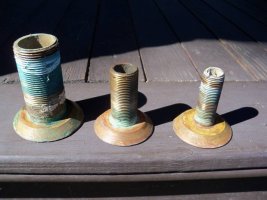Okay, I believe I've solved this riddle, and I'll pass along the solution to other Ericson owners who may also have 1-1/4 inch through-hulls.
A through-hull that measures 1-1/2 OD and 1-1/4 ID is officially known as a "1-1/4 through-hull." This is what Ericson installed in my E25 in 1975.
A "1-1/4 through-hull" requires what is called a "1-1/4 valve" or, more commonly now, a "1-1/4 seacock." I took a look today at the old valve, which I recently discarded. It was indeed labeled "1-1/4."
Atop the valve or seacock there needs to be what is called a "1-1/4 tail piece" or "1-1/4 pipe-hose adaptor." The "tail piece" or "pipe-hose adaptor" has barbs on one. It's onto these barbs, of course, that the sanitation hose is clamped. Here's where the trouble begins. Normally, this barbed section of the "tail piece" or "pipe-hose adaptor" is narrower than the threaded section on the other end - about 1/4 inch narrower. This means that the interior size of the standard "1-1/4 tail piece" or 1-1/4 pipe hose adaptor" is reduced from 1-1/4 inches to 1 inch. This reduction or tapering is necessary for the fitting of the hose onto the barbs. A hose is measured by its interior dimensions. Thus, 1-1/4 inch hose would not fit onto a 1-1/4 inch tail piece or pipe hose adaptor unless one end were tapered. While all of this fits together nicely, the fact remains that there is one section of this system where the all of the waste must pass through a narrow, 1 inch funnel of sorts. If I may say so, this appears to be a system ripe with problems.
You can more easily avoid these problems by starting things off with a 1-1/2 inch through-hull. On top of this you would place a 1-1/2 inch seacock, followed by a 1-1/2 inch tail piece or pipe hose adaptor. If, however, you used a standard barbed tail piece or pipe hose adaptor you would still have a narrow part in your system. Your 1-1/2 inch interior size would be reduced to 1-1/4 inch. This reduction would be necessary for fitting the 1-1/2 inch ID sanitation hose onto the barbs.
The problem of the narrowing of the tail piece or pipe hose adaptor can be avoided, of course, by using a full flow pipe hose adaptor such as those made by Groco. Full flow adaptors do indeed have barbs, but they do not taper. In other words, a 1-1/4 inch full flow pipe hose adaptor is 1-1/4 inches ID from one end to the other. This means that on the barbed end, you are able to use a 1-1/2 inch ID sanitation hose. This is good, because 1-1/2 inches ID is, of course, the standard size for sanitation hoses. It's also good because most toilets and most holding tanks have 1-1/2 ID connections.
Summary 1:
1-1/4 through hulls and 1-1/4 seacocks are appropriate for standard 1-1/2 sanitation hoses and 1-1/2 toilet outlets and holding tank inlets as long as you use a 1-1/4 full flow pipe hose adaptor.
Summary 2:
1-1/2 through-hulls and 1-1/2 inch seacocks are preferable because they provide a wider passage at the waste outlet end of the system. There are, however, 1-1/4 inch ID passages within the system. The tail piece or pipe hose adaptor, for instance will be 1-1/4 inches ID. Also the waste outlet on the toilet will be 1-1/4 ID, because the 1-1/2 ID hose must be able to fit around it. It seems there is no way to avoid these narrow points. You could use a full flow pipe hose adaptor, but that would require a larger sanitation hose than 1-1/2 inches ID. This would create other problems in terms of joining the hose to the toilet and holding tank.
Am I on the mark with this analysis, or have I wandered far off course?
Thanks for the help,
Roscoe

